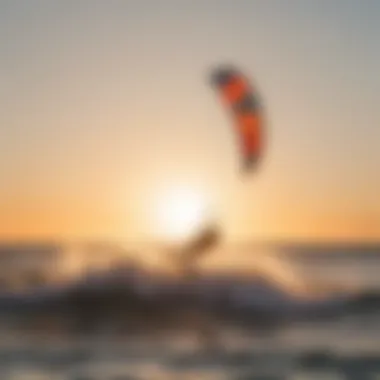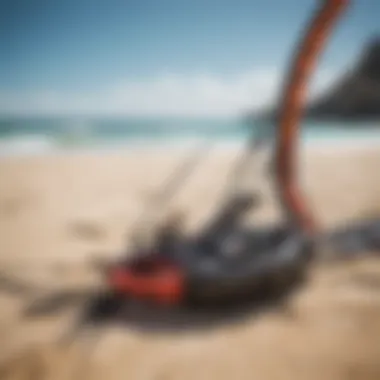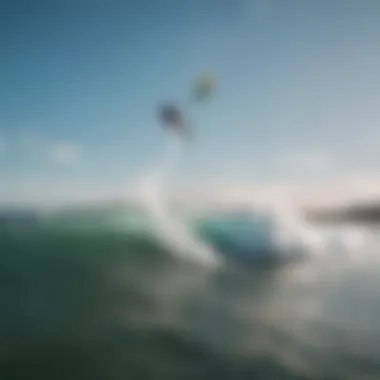Kitesurfing Holidays: Adventure and Relaxation


Intro
Kitesurfing holidays attract thrill-seekers from all walks of life. The blend of soaring through the air, slicing across water, and connecting with nature is quite enchanting. Picture yourself strapping on a harness, feeling the wind's rush as it fills your kite and lifts you off the water. It’s not just a sport; it’s a lifestyle. This article dives into the essence of kitesurfing trips, exploring essential techniques, gear options, and safety tips, all while touching on local cultures and environmental factors.
Join us as we unravel where to go, what to know, and how to enhance the overall experience whether you’re just starting out or you have a few tricks up your sleeve. Let’s navigate these vibrant waters together, ensuring everyone from rookies to seasoned pros finds something valuable here.
Techniques
Beginner Kiteboarding Techniques
Starting out in kitesurfing can feel overwhelming. However, the right techniques can transform your experience from daunting to exhilarating. A solid foundation is essential, so here are some key techniques suitable for newcomers:
- Body Dragging: This fundamental skill teaches you how to control the kite while being dragged through the water. Focus on covering your body and using smooth, controlled movements.
- Water Start: Getting up on the board is the next big leap. Position the board correctly, keep your weight centered, and let the kite pull you upright.
- Riding Upwind: It’s crucial to learn how to ride against the wind so you can return to your starting point without drifting off. Practice maintaining your speed and direction while adjusting your kite’s angle.
Advanced Freestyle Maneuvers
For those who’ve mastered the basics and feel that itch for progression, the world of freestyle kitesurfing awaits. Elevating your skills involves understanding tricks that require both agility and finesse. Here are some advanced maneuvers:
- Holy Grail: This trick involves grabbing the board mid-air, adding a stylish flair to your jumps. Timing is key to achieving a smooth transition.
- Backroll: Execute a backroll by jumping high and tilting your head over your shoulder as you rotate backward. Once landed, keep the kite low to maintain your momentum.
- Handle Pass: A true showstopper, this maneuver requires you to pass the kite handle from one hand to the other mid-air. It demands speed, power, and precision.
"Practicing on different conditions can accelerate your learning. Don’t shy away from windier days to refine your skills."
Gear Reviews
Latest Kiteboarding Equipment
Staying updated with the latest gear can significantly enhance your kitesurfing experience. Here’s a peek at some equipment that's making waves this season:
- Kite Types:
- Boards:
- All-Terrain Kites (like the Duotone Rebel): Ideal for various wind conditions.
- Freestyle Kites (such as the Naish Pivot): Designed for performance jumps and tricks.
- Directional Boards (like the Slingshot Binge): Great for wave riding.
- Twin-Tip Boards (like the RRD Vision): Excellent for freestyle and general kitesurfing.
Essential Accessories for Kiteboarders
Accessories can make or break your kitesurfing endeavors. Here are must-have items:
- Control Bar: A high-quality control bar is essential for handling your kite effectively. Look for models with comfortable grips.
- Impact Vest: Safety first! An impact vest protects you during unexpected falls.
- Harness: A well-fitted harness ensures comfort while providing the necessary support. It’s worth investing in a good one.
Kitesurfing encompasses more than just the sport itself; it invites you into a community and a world of adventure. With the insights shared, you’re well on your way to planning your perfect kitesurfing holiday!
Understanding Kitesurfing Holidays
Kitesurfing holidays represent more than just a chance to catch some waves; they embody a unique blend of dynamism, relaxation, and personal growth. Diving into this thrilling world offers participants a chance to connect with nature, enhance their physical skills, and immerse themselves in diverse cultures. As kitesurfing becomes increasingly popular, understanding the various elements surrounding kitesurfing holidays is crucial for anyone looking to maximize their experience.
Definition and Overview
At its core, a kitesurfing holiday refers to a vacation during which one engages in the sport of kitesurfing. This energetic sport combines elements of surfing, windsurfing, and paragliding. A participant rides a board while being pulled by a large kite across the water; it’s exhilarating, challenging, and full of possibilities.
When we talk about kitesurfing holidays, we don’t just mean practicing the sport; we also refer to a holistic experience that may include travel, learning, communal activities, and appreciating local environments.
Key benefits of engaging in kitesurfing holidays include:
- Skill Enhancement: Each holiday offers the chance to improve skills, whether one is just starting or has years of practice.
- Community Connection: Joining a group of fellow enthusiasts fosters connections that often lead to lifelong friendships.
- Cultural Immersion: Traveling to various destinations allows a deeper understanding of local customs and traditions.
Historical Context of the Sport
To truly appreciate kitesurfing holidays, it’s essential to touch on the sport's historical context. Kitesurfing traces its roots back to the 12th century, with early uses of kites appearing in China for military purposes. Fast forward to the 1990s, and a handful of visionary sports enthusiasts started experimenting with kites that could propel a surfboard.
Kitesurfing rapidly evolved, gaining traction in windsurfing circles and eventually solidifying itself as a standout sport by the early 2000s. Not only did it enhance recreational opportunities along coastlines worldwide, it also defined a new cultural phenomenon focusing on adventure and freedom. People began flocking to coastal destinations to engage in this thrilling activity.
To today’s kiteboarders, the sport is a fusion of thrill-seeking and mindfulness. From die-hard pros performing aerial tricks to casual cruisers enjoying the surf, its rich history blends with contemporary practices, making kitesurfing holidays an enticing pursuit.
"Kitesurfing is not just a sport; it's a way to break boundaries and fly against the wind."
Ultimately, understanding the essence of kitesurfing holidays allows individuals to navigate this exhilarating domain more thoughtfully. Participants can embrace the sport's intricacies and prepare for a journey that promises not only adventure but also personal enrichment.
Choosing the Right Destination
Selecting a destination for kitesurfing holidays can be the defining factor in the overall experience of travelers and adrenaline junkies alike. The right spot not only enhances the thrill of catching wind but also influences skill development, relaxation opportunities, and cultural immersion. With diverse choices spread out across the globe, travelers must consider various elements to ensure they’re choosing a location that aligns with their preferences and skill level. Here’s a closer look at some of the most vital components while deciding on a perfect kitesurfing getaway.
Top Global Kitesurfing Locations
Europe
Europe is home to some of the most renowned kitesurfing spots, attracting enthusiasts from all walks of life. Particularly, places like Tarifa in Spain boast consistent winds and crystal-clear waters, making it an ideal playground for both newbies and advanced riders. The European landscape, dotted with pristine beaches and vibrant cultures, enriches the kitesurfing journey.
- Key characteristic: Variety of Conditions
European destinations often present diverse conditions. This means surfers can tackle flat waters in places like the lagoons of Greece, while coastal waves challenge seasoned professionals. - Unique feature: Cultural Blend
Travelers get the added benefit of discovering local traditions, which enhances the experience beyond just kitesurfing. For instance, enjoying a fresh pint of local ale post-session in a beachside tavern serves as a reminder that it's not all about the adrenaline.
North America
North America features a mix of landscapes that suits kitesurfers looking to combine adventure with stunning vistas. Locations like the Outer Banks in North Carolina are famed for their warm waters and steady winds. They serve as perfect conditions for learning and progression.


- Key characteristic: Accessibility
Many kitesurfing locations are equipped with schools and rentals that make it easy for novices to dive in without having to pack extensive gear. - Unique feature: Diverse Ecosystems
From the scenic dunes of Cape Hatteras to the breathtaking sunsets over the Pacific in California, the ecosystems provide a picturesque backdrop for kitesurfing, influencing the overall ambiance.
Asia
Asia remains an ever-growing frontier for kitesurfing enthusiasts. Countries like Thailand and Vietnam don’t merely impress with their rich cultures but also boast splendid beaches perfect for the sport. Locations such as Hua Hin have captivated kiteboarders with expansive beaches and reliable winds.
- Key characteristic: Affordable Travel
Many of these destinations offer budget-friendly options that can please those looking to stretch their wallet while still indulging in high-quality experiences. - Unique feature: Vibrant Local Culture
Kitesurfing in Asia often comes with opportunities to explore unique cultural practices and stunning natural beauty, offering a holistic adventure that blends sport with cultural appreciation.
Australia
Australia’s coastline is a treasure trove for kitesurfing. The spots in places like the Gold Coast draw riders from all corners, providing perfect conditions year-round.
- Key characteristic: Ideal Weather
The steady trade winds here and warm waters invite kitesurfers to push their limits or simply enjoy some leisurely rides. - Unique feature: Diverse Terrain
From the bustling beaches near Sydney to the rugged coastlines, Australia provides a wide array of experiences, ensuring that every kitesurfing holiday feels unique and invigorating.
Considerations for Location Selection
Wind Conditions
Wind conditions are perhaps the most pivotal factor in choosing a destination. Not all locations suit every skill level; some spots cater specifically to beginners with gentle breezes, while others demand experience with gusty winds. Kitesurfers should always pay heed to the prevailing conditions based on their personal abilities and comfort levels, ensuring they do not feel overwhelmed or bored.
- Key characteristics: Consistency and Strength
Strong and steady winds are essential for vibrant sessions, especially in areas that boast year-round kitesurfing opportunities.
Water Types
Different water types, such as flat lakes, choppy seas, or big waves, offer unique challenges and experiences. Beginners often thrive in flat, shallow water where they can comfortably learn, while experienced riders may seek the thrill of wave riding.
- Key characteristic: Safety and Comfort
Flat waters are easier for newbies to navigate, reducing the fear factor and allowing them to focus on technique instead of balance.
Local Culture
Kitesurfing is not just about the wind and water; it’s also about the community and culture surrounding the sport. Understanding local customs can enhance one’s experience manifold. Engaging with local kiteboarding clubs or even participating in community events can foster stronger connections and provide the opportunity for unique cultural exchanges.
- Key characteristics: Community Engagement
A warm and inviting community can make even the most challenging of rides feel welcome. Getting involved locally translates to sharing tips, experiences, and maybe even lifelong friendships.
In summary, the right destination for kitesurfing can significantly enhance your experience, from learning opportunities to community connections. Choosing wisely can result in unforgettable adventures both on and off the water.
Essential Gear for Kitesurfing
Kitesurfing, while offering thrilling experiences across majestic waters, demands specific gear to ensure safety and performance. The right equipment can elevate your experience from just riding the waves to mastering them. This section dissects essential gear for kitesurfing, providing insights that both seasoned kiteboarders and fresh enthusiasts will appreciate.
Kites: Types and Functions
At the heart of kitesurfing is the kite itself. The type of kite one chooses significantly influences handling and performance on the water. There are generally three main types: C-kites, Delta kites, and Bow kites.
- C-kites are ideal for those seeking high performance and are preferred by advanced riders for tricks and jumps. They offer direct control and have a distinctive C shape, allowing for strong pull and quicker turning.
- Delta kites excel in stability and ease, making them perfect for beginners. Their design allows them to fly well in lighter winds and supports easier water re-launches.
- Bow kites provide a fantastic compromise between performance and user-friendliness. They have a unique adjustment feature that helps with depowering the kite, suitable for varying wind conditions.
Understanding these differences lets a kitesurfer choose a kite that matches their style and skill level, ultimately enhancing their holiday experience.
Boards: Choosing the Right Style
Selecting the right board can either make or break your time on the water. There are various types of boards—strapless, strapped, and directional—that serve different purposes.
- Strapless boards are typically favored for freestyle riding and tricks, offering a closer connection between the rider and the board. This enhances maneuverability and helps with transitions, but might be challenging for those just starting out.
- Strapped boards, on the other hand, provide security. They are ideal for a smooth ride on choppy waters and are generally recommended for beginners.
- Directional boards are similar to surfboards and are perfect for those who enjoy riding waves. They allow for carving through rough waters, providing a different set of thrills.
Choosing the right style often comes down to personal preference and the type of conditions you plan to ride in.
Safety Equipment and Clothing
Safety gear is just as crucial as performance gear when it comes to kitesurfing. Being adequately protected not only enhances enjoyment but also builds confidence out on the water. Here, we look at harnesses, helmets, and impact vests, all of which play key roles in safeguarding the kitesurfer.
Harnesses
Harnesses are the unsung heroes of kitesurfing gear. They distribute the kite's pull across the body, relieving pressure on the arms and enabling longer rides without tiring out.
- Key characteristic: A good harness should fit snugly without being restrictive.
- Advantage: Many riders opt for waist harnesses due to their comfort and ease of movement. They allow more freedom in the upper body, which is beneficial for maneuvering.
- Unique feature: Some harnesses come equipped with additional padding, offering improved comfort and support, correlated to prolonged sessions without discomfort.
Helmets
Helmets are often overlooked but are essential for any serious kitesurfer. The reality is that the risks involved with falls or collisions warrant the inclusion of this protective gear.
- Key characteristic: Lightweight design without compromising on durability.
- Advantage: A well-fitting helmet protects against head injuries, especially during turbulent conditions or when practicing tricks.
- Unique feature: Many helmets include ventilation systems to keep you cool and comfortable while riding.
Impact Vests
Impact vests play a significant role in cushioning against hard falls. They are particularly important for those pushing their limits in freestyle maneuvers.
- Key characteristic: They are designed to absorb impact while allowing for flexibility.
- Advantage: By wearing an impact vest, riders can have increased confidence when attempting new tricks, knowing there’s an added layer of protection.
- Unique feature: Some vests come with flotation assistance, which can be helpful for beginners or in rougher waters, providing dual purpose safety.
As you prepare for your kitesurfing holiday, considering these elements of essential gear can significantly enhance your enjoyment and safety while exploring the intricacies of kitesurfing.
Skill Development During Holidays
Kitesurfing holidays are not simply an escape from the grind of daily life; they are an opportunity to hone your skills, immerse yourself in the sport, and elevate your abilities on the water. This aspect is essential for anyone looking to get the most out of their kitesurfing experience. Skill development not only enhances one’s proficiency but also boosts confidence, allowing individuals to explore more challenging maneuvers and new tricks. A structured approach to learning during a holiday can lead to significant improvement, making every session on the water fruitful.
Finding the Right Instruction


Choosing the right instruction is pivotal when it comes to skill development. Not all instructors are created equal, and their teaching styles may vary significantly. Look for schools that prioritize tailored lessons; they offer programs adjusted to your skill level and learning pace. Before signing up, consider checking online reviews or asking for recommendations in local kitesurfing communities. Going through resources such as Facebook or Reddit can yield valuable information about local instructors and schools.
Instructors with certified qualifications, such as from the International Kiteboarding Organization (IKO) or the British Kitesurfing Association (BKSA), are best suited to guide you. Their experience and knowledge ensure that you not only learn efficiently but also keep safety a top priority while teaching.
Progression Techniques for Various Levels
Beginner
For those just starting their kitesurfing journey, it's crucial to focus on foundational skills. Knowing how to set up your kite and understanding the basic controls can make a world of difference. A significant characteristic of beginner training is the focus on safety protocols and self-rescue techniques. It benefits beginners immensely because it instills the necessary knowledge to handle themselves in potentially risky situations. The unique feature of beginner lessons is often the support from instructors who are patient and encouraging, helping newcomers get comfortable with the equipment and the water. This nurturing environment can ease the initial anxiety often associated with learning kitesurfing.
Intermediate
Moving into the intermediate level, riders start to master the basics and aim for more advanced maneuvers, such as jumps and tricks. A key characteristic here is the emphasis on refining techniques. Intermediate kitesurfers are encouraged to experiment with their style and adapt techniques that suit their riding conditions. At this level, one can face challenges like tackling stronger winds or tricky water conditions. The advantage is that greater skill sets allow for exploration of diverse locations and improve adaptability. However, without proper guidance during progression, there is a risk of developing bad habits that can be hard to break later. An instructor’s guidance can help identify areas of improvement and instill a solid understanding to build upon.
Advanced
For those at the advanced level, skill development shifts towards mastering complex maneuvers and high-level tricks. The mark of an advanced kitesurfer often includes finesse in their techniques and a deep understanding of wind and water dynamics. One critical characteristic of advanced training is fine-tuning existing skills while learning new tricks that push personal boundaries. Advanced riders often focus on performance metrics, analyzing their runs and strategies extensively. A distinctive feature is the camaraderie among other advanced riders, providing a platform where individuals can share tips and feedback, which helps in overcoming plateaus. The downside may be that without regular challenges, motivation can dip, leading to stagnation unless one actively seeks out new goals and experiences.
"The more you know, the more you can do. And that rings especially true on the water; every session should be about progression."
Safety Considerations in Kitesurfing
Kitesurfing, while exhilarating, serves up a hefty plate of risks that make safety considerations absolutely paramount. Whether you're a wet-behind-the-ears beginner or an experienced kiteboarder, understanding the potential hazards—both natural and man-made—allows you to enjoy this sport while minimizing risks. Safe practices aren’t just good for you, they contribute to the overall enjoyment and security of the kitesurfing community. Every wave you conquer and every gust you ride should be met with respect for safety protocols to ensure that your adventure does not tip over into disaster.
Understanding Weather Patterns
Weather can be the unsung hero—or villain—of your kitesurfing escapade. Mother Nature dictates the conditions, and a firm understanding of weather patterns is crucial in planning your kiteboarding sessions. You’ve got to be attuned to wind direction, speed, and tide, because what feels exhilarating in calm conditions can quickly turn to chaos in gusty winds.
- Wind Speed: Kitesurfing is only as good as the wind conditions. Ideally, look for winds between 12 to 25 knots. Anything below might feel like paddling in molasses, while winds exceeding 30 knots can turn the sea into a chaotic dance of peril.
- Tide Awareness: Knowing how tides work can save a surfer from being carried off by the currents. Some spots are tide sensitive—go against the flow at your peril, especially if you’re a novice.
- Forecast Tools: Apps and websites like WindFinder and Windy offer detailed forecasts. Check these regularly. They’re not just for planning; they can save your skin.
"Keep one eye on the horizon and the other on the clouds. A savvy kitesurfer knows that weather is key to a successful ride."
Adapting to changes in the weather should be second nature. For instance, a sunny day can take a sharp turn when a storm rolls in; always have an exit plan and cue into the signs around you.
Risk Management Strategies
Solid risk management is your umbrella against the storm in kitesurfing. You might find that it simplifies your experience and leaves you more room to enjoy the pint-sized thrill of riding the waves.
1. Pre-Session Checks: Do a thorough check of your gear. Look for nicks or tears on the kite, and ensure the lines are untangled and free of knots. Regular maintenance of equipment is not just good practice; it’s a must.
2. Buddy System: Never go flying solo, especially when you’re in unfamiliar waters. Riding with a partner enhances safety and allows for assistance in emergencies. Just knowing someone is nearby can soften the edge of anxiety.
3. Take Classes: Investing time in professional lessons adds a layer of mitigation against risks. Instructors can teach you how to discern situations that might end up in mishaps.
4. Emergency Protocols: Understand how to react in various situations. For example, if you become unseated, have a plan for quick re-launching. Every second counts when facing unpredictable water conditions.
5. Knowledge of Local Risks: Every destination has its own set of risks, from hidden rocks to boat traffic. Local instructors can offer insight about hazards you may not have considered.
Committing to safety protocols elevates your kitesurfing experience and fosters a culture of responsibility that benefits all riders. So, as you gear up for your next adventure, remember: safety might not be thrilling, but it’s the key ingredient to ensuring you can keep kitesurfing for years to come.
Connecting with the Local Kiteboarding Community
Engaging with the local kiteboarding community can significantly enhance a kitesurfing holiday. It’s not just about riding the waves; it's about soaking in the culture, developing connections, and even picking up on nuanced local practices that can shape one’s kitesurfing experience. For kitesurfers, having a support network can be beneficial both on and off the water. Apart from safety, it enhances skill development through shared experiences and tips that locals are more than happy to provide.
By tapping into the local scene, you craft a unique vacation that feels alive, dynamic, and filled with possibilities. It’s also a way to ensure that your time spent in new locations is respectful and aligns with the values of the local communities.
Joining Group Sessions and Events
Participating in group sessions and kiteboarding events is an excellent way to immerse oneself in the community. Many kitesurfing destinations host regular meetups or competitions that welcome riders of all levels. These events offer a proving ground for skills where everyone from beginners to seasoned veterans can find a spot. Joining these groups not only builds camaraderie but also allows you to learn from others' experiences.
- Friendship and Networking: You’re more likely to forge friendships with those who share your passion for kitesurfing. Potential connections can lead to new adventures or partnerships in kiteboarding.
- Skill Exchange: Group settings create opportunities for skill exchanges, where you can share your expertise while learning from others as well.
- Local Knowledge: Engaging with locals through events provides insights into the best spots, equipment rentals, and even hidden gems off the beaten path.
Additionally, there’s a certain thrill in participating in a friendly competition. The adrenaline of competing can elevate your skill level, and you will find encouragement from fellow participants.
Building Relationships with Local Instructors
Finding a reliable local instructor can be a game-changer during a kitesurfing holiday. Local instructors are not just teachers; they are seasoned riders who understand the waters, winds, and specific quirks of the area’s geography. Building a rapport with them can also lead to personalized instruction that is tailored to your unique skill level and needs.
Consider the following aspects when establishing connections with instructors:
- Trust and Reliability: A familiar instructor can provide consistent feedback and guidance, making progress smoother.
- Cultural Insights: Local instructors can also act as cultural ambassadors, providing rich insights that go beyond kitesurfing itself. Their understanding of local customs can enhance your overall experience.
- Safety First: Establishing a solid relationship helps you feel comfortable discussing any concerns regarding safety and adapting to the local environment. Instructors are often attuned to risks that a visitor may overlook, and their advice is invaluable.
Moreover, a genuine connection with a local instructor often leads to exclusive insider tips, whether that’s where to find the ideal wind conditions or secret spots not widely known to tourists.
"The kiteboarding community is not just about the sport; it's about creating lasting connections and gaining experiences that broaden your horizons."
Connecting with the local kiteboarding community enriches not only your kitesurfing skills but also provides a lens through which to view the local culture and environment, making for a truly memorable holiday.
Cultural Aspects of Kitesurfing Destinations
When one embarks on a kitesurfing holiday, the thrill of riding the waves isn't the only allure. The cultural aspects of kitesurfing destinations play a significant role in enhancing the overall experience. From local traditions to regional cuisines, immersing oneself in the local culture can deepen the love for the sport while also fostering a sense of connection. Not only does culture enrich the experience, but it also promotes respectful interactions with host communities.
Understanding Local Customs


Before setting sail, learning about local customs and practices is essential. Each kitesurfing destination has its unique characteristics, shaped by history and culture. For instance, in Tarifa, Spain, practitioners often greet with a warm handshake, while in Cabarete, Dominican Republic, it’s common to share tips over a casual drink at the beach bar after a session. Knowledge of these subtleties helps one navigate social situations appropriately and avoid any faux pas.
Moreover, something simple like understanding when local holidays might be can influence your experience. Festivals may lead to crowded beaches or even temporary closures of typical kitesurfing spots. Being aware allows for better planning and maximizes time on the water. Additionally, participating in local festivities can enrich your holiday and create memories that go beyond just kitesurfing.
Respecting the Environment
Kitesurfing takes you to some of the most pristine natural environments, from untouched beaches to vibrant marine ecosystems. With the beauty comes a responsibility to protect these landscapes. Respecting the environment is not just an option; it is a requirement for conscious kitesurfing.
Consider these practices when engaging in kitesurfing:
- Gear and Waste Disposal: Always dispose of plastic waste properly. Many kitesurfing locations offer designated bins.
- Wildlife Interactions: Observing local wildlife should be done from a distance. Never chase or disturb birds or marine animals.
- Local Regulations: Every location has its own set of rules. Research and respect local guidelines regarding kitesurfing zones and conservation efforts.
By taking care of the environments we play in, kitesurfers contribute to the sustainability of their favored spots. Further, sharing the importance of these practices with fellow kite enthusiasts can foster a community dedicated to environmental stewardship.
"Understanding the culture of your kitesurfing destination isn’t just about riding the waves; it’s about leaving a positive imprint on the shores you visit."
In all, understanding local customs and respecting the environment equal a richer and more responsible kitesurfing experience. This awareness not only enhances personal enjoyment but also contributes to the legacy of kitesurfing as a sport that harmoniously coexists with nature and culture.
Post-Holiday Reflection
Reflecting upon your kitesurfing holiday is an essential practice that goes beyond merely recalling sun-soaked days on the water. It serves multiple purposes, from assessing your personal growth in the sport to setting the stage for future achievements. This process anchors your experiences, ensuring that lessons learned and skills gained are not left behind once the holiday draws to a close.
Before diving into how to evaluate your skill set and set new goals, it is crucial to understand various benefits of this reflection:
- Enhances Learning: By reviewing what worked well and what didn’t, you can pinpoint specific techniques that need improvement.
- Boosts Motivation: Recognizing your progress can be a morale booster, promoting a desire to advance and take on new challenges in upcoming trips.
- Encourages Mindfulness: This practice fosters a deeper connection with the sport and nature, leading to a more enriching kitesurfing experience.
"Reflection is not about where you have been, but about where you are going."
Evaluating Skill Improvement
Assessing your progress in kitesurfing can sometimes feel daunting, but it’s fundamentally about honesty with yourself. To evaluate skill improvement effectively, consider the following aspects:
- Self-Assessment: After your trip, take a moment to jot down what you achieved on the water. Were you able to control your kite better than before? Did you land tricks that once seemed out of reach? This personal inventory is vital for understanding growth.
- Feedback from Instructors: If you took lessons or joined group sessions, reach out to your instructors for their insights. They can provide objective evaluations that highlight your strengths and areas needing further development. Their perspective can also reassure you of your capabilities, sometimes more than you realize.
- Video Analysis: If you recorded your sessions, trekking back through the footage can reveal nuances in your technique you may have missed while riding. Watching your movements in real-time can spark new ideas about improving your skills.
Setting Goals for Future Progress
Once you have taken stock of your past performance, the next step is formulating concrete goals to guide your kitesurfing journey onward. Here are some strategies for effective goal-setting:
- Specificity Over Generality: Make sure your goals are clear. Instead of saying, "I want to get better at kitesurfing," specify what that looks like. A more detailed goal could be, "I want to consistently land a backloop by my next trip."
- Achievable Milestones: Break larger objectives into smaller, manageable tasks. This approach allows you to celebrate small wins, keeping the motivation alive between holidays. If your main goal is to travel and kite in new locations, a mini-goal could be researching new spots or planning a weekend trip.
- Time Frame: Assign deadlines to your goals, creating urgency and commitment. Whether it’s within three months or six weeks, having a timeline helps keep distractions at bay and the focus on the task at hand.
In the end, the practice of post-holiday reflection goes hand in hand with the evolution of your kitesurfing journey. Embracing this process can transform each holiday into a stepping stone toward becoming the kiteboarder you've always aspired to be.
The Role of Technology in Kitesurfing
In today’s interconnected world, tech plays a pivotal role in enhancing the kitesurfing experience. From tracking performance to guiding kitesurfers through innovations in gear, technology reshapes how enthusiasts engage with the sport. It's not just about catching the right wind conditions anymore; technology introduces a new dimension, making every session more enriching and effective for both learners and advanced riders alike.
Applications for Monitoring Performance
Performance monitoring is now a fundamental aspect of kitesurfing, with various apps and devices designed to analyze metrics such as speed, height of jumps, and duration on water.
These applications can:
- Provide real-time feedback, helping riders adjust their techniques live
- Analyze data post-session, offering insights into areas needing improvement
- Document progress over time, which can serve as great motivation
For instance, tools like KiteBuddy and KiteLog help users gather performance metrics in a user-friendly format. They allow kitesurfers to understand their strengths and hurdles.
When utilizing wearables like smartwatches, kitesurfers enjoy an edge in understanding environmental conditions—wind speed, wave forecasts—and hence can make more informed decisions. This intersection of data and performance not only hones skills but also aligns a kitesurfer’s ambitions with measurable achievements.
"In the age of information, those who collect data diligently often wind up leading the pack."
Innovative Gear Advances
Gear technology continues to advance, providing kitesurfers with more intuitive and customizable equipment than ever before. The latest kites and boards are engineered with lightweight materials and innovative designs aimed at performance and safety.
Key advancements include:
- Smart Kites that adjust to wind conditions autonomously
- Heated Impact Vests offering enhanced safety and comfort for cold water surfing
- Adjustable Boards that allow riders to customize dimensions based on skill level and conditions
Such innovations not only boost performance but also enhance safety, which is paramount. The latest harnesses integrate safety systems to prevent accidents during daring maneuvers, while kites featuring automated release mechanisms provide an extra layer of security in turbulent environments.
By incorporating these modern technologies into practice, kitesurfers can not only enjoy their time on the water but also propel their skills forward, all while dramatically reducing the risk often associated with extreme sports.
Kitesurfing and Wellness
The connection between kitesurfing and wellness isn't just a passing thought; it's an essential aspect that beautifully intertwines physical activity with mental health benefits. Engaging in kitesurfing not only serves as an outlet for physical exercise but also delivers therapeutic effects that are critical in today's fast-paced lifestyle. For those looking to break away from the mundane, kitesurfing can reframe your approach to both fitness and well-being.
Physical Benefits of Kitesurfing
Kitesurfing is a full-body workout that targets various muscle groups, fostering overall strength and endurance. Here are a few key physical benefits:
- Strength Training: Getting afloat requires core strength. Balancing while navigating the water works on your abdominal and lower back muscles.
- Cardiovascular Wellness: Paddling out and maneuvering through the waves effectively increases heart rate, offering an intense cardiovascular workout.
- Flexibility and Balance: Catching the wind and adjusting your body position builds agility, enhancing your coordination and flexibility.
Kitesurfing forces the body to adapt to constantly changing conditions, from shifts in the wind to variations in water types. Generally speaking, the more you practice, the more agile your body will become, making day-to-day activities feel much easier. It's not just about riding the waves; it’s about shaping the way your body moves.
Mental Health Aspects
Kitesurfing offers more than just physical exhilaration. It provides a significant mental health boost as well. These aspects can be life-changing:
- Stress Relief: Being out on the water, feeling the breeze, and focusing solely on riding can transport your mind away from daily stressors, presenting a fresh outlook.
- Boosted Confidence: Learning new tricks and mastering different techniques can elevate self-esteem, as each achieved goal builds a sense of accomplishment.
- Social Connection: Kitesurfing often takes place in vibrant communities, which enable connections with like-minded individuals, fostering friendships and support systems.
"For every session on the water, there’s a newfound clarity waiting on the shore."







